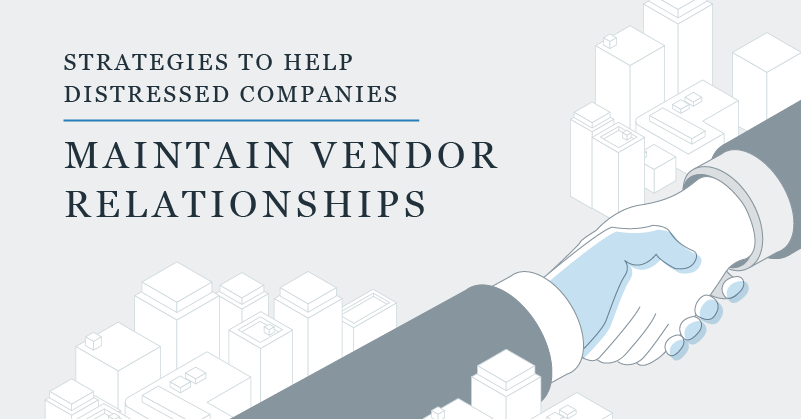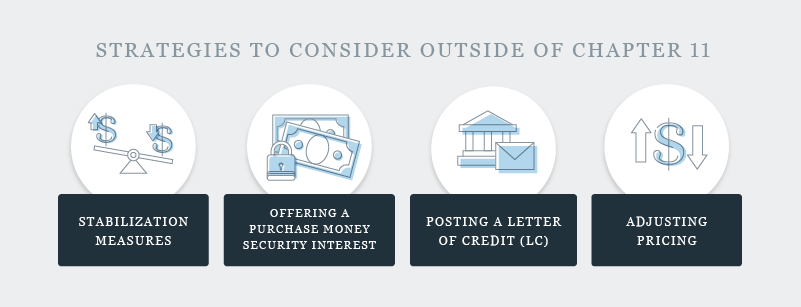
There’s no shortage of challenges that distressed companies face. One vital consideration that these businesses have to manage is maintaining vendor relationships. If important partnerships begin to falter, this can magnify other difficulties that the business is currently undergoing, making it more difficult to recover. Remaining in good standing with your suppliers could help you continue operations as you get your financial house in order.
We’ll explore techniques and tactics that businesses can leverage in their efforts to sustain healthy vendor relationships. Specifically, we’ll focus on tools that can be deployed for entities that are experiencing hardship but not currently involved in bankruptcy proceedings, as well as avenues worth exploring during Chapter 11.

Strategies to consider outside of Chapter 11
If your business is going through a financially turbulent period, it’s important to consider the impact this will have on your vendors. Savvy business leaders will make proactive efforts to reassure suppliers that they can right the ship and satisfy the obligations to the business partner. This way, the company can maintain the flow of goods and keep its operations running. In time, this can help the currently distressed company resolve outstanding financial difficulties and chart a new course.
Often, trust between the vendor and company has been lost. There were promises of payment that remained unfulfilled. In this case, the company should consider bringing in an independent third party that doesn’t have the baggage of past relationships and unkept promises.
The following techniques can assist businesses that are currently struggling — but that are not involved in a formal insolvency proceeding — to help manage ongoing vendor relationships during challenging circumstances. The company should consider implementing some or all of these techniques with the help of an independent party.
Keep in mind that if you are experiencing liquidity constraints, some of these suggestions may increase that pressure. Alternatively, you could place a hold on any past-due debts and pay only with cash on delivery for the near future, effectively eliminating the risk to the vendor going forward.
Stabilization measures
Allocation of limited cash resources among suppliers is a challenge especially without the benefit of a Chapter 11 filing. Experienced restructuring advisors utilize strategies that fulfill the objective for continued support from the vendor community. First, it’s prudent practice to segregate vendors into active and inactive categories.
You have not or will no longer be doing business with the inactive vendor, and accordingly, satisfaction of their past due balances will do nothing to promote the flow of goods or services. However, inactive vendors cannot easily be ignored since collection demands and litigation efforts will ensue. To manage this risk, management should be proactive in settling at a significant discount. This strategy is feasible only if you have access to cash designated for this purpose. The sale or disposition of non-core and nonperforming assets may be required. You would need to be transparent to achieve such a result, through proactive sharing of financial information and good faith negotiations. By the end of the process, inactive vendors would have performed sufficient diligence to form their own conclusions on your prospects for repayment. Without the prospect for continued business, together with the real risk of a 100% write-off, inactive vendors are likely to agree to a substantial discount on their claims. If inactive vendor balances are many in number and dollar amount, the inability to implement these strategies may require a Chapter 11 filing.
Active vendors require careful strategic consideration for a successful outcome. The key is to provide a solution that will protect the creditor from continued payment risk and harm, while at the same time provide a logical value proposition to entice vendors to provide goods or services. More strategic liquidity would be employed for active vendors, buoyed with the cash preserved from allocations away from inactive vendors. One strategy is to agree to a moratorium on the past due balances and offer cash in advance or on delivery prospectively. This will allow the vendor to continue to profitably sell its goods or services with no additional risk of non-payment. If such an arrangement is not acceptable to the vendor and cash flow permits, a payment plan on the past due balances may be necessary, together with shortened credit terms, for future business. The value proposition for the vendor is premised on the prospect of earning margins, while at the same time mitigating against increased exposure and payment risk.
Offering a purchase money security interest (PMSI)
In a situation where your vendor reasonably believes it could be competing with other creditors for debt repayment, PMSIs provide the supplier with certainty that its claim will be prioritized over other parties in the event of a default. The goods sold by the vendor can serve as collateral. PMSIs can be difficult to exercise in situations where the company has a secured loan. In such circumstances, it may be necessary to get permission from the secured lender.
Posting a letter of credit (LC)
Working with a third-party bank, you could post an LC, which serves as a contingent obligation in case the vendor does not receive your company’s payment in a timely manner. You’ll negotiate the terms of the LC with your bank, and the supplier will draw on this instrument if payment is not delivered as specified.
Adjusting pricing
Working with your supplier, you’ve likely settled on an agreed-upon pricing structure. If you adjust the terms of that arrangement in the vendor’s favor, that supplier may be more willing to provide you with trade credit.
Strategies during Chapter 11
If your business is involved in a Chapter 11 proceeding, your options change. This process precludes distressed companies from repaying vendors for most obligations that arose prior to the legal filing.
Fortunately, there are still steps that you can take, and there are options that are open to your suppliers as well. The terrain can be difficult to navigate at first, but keep these key strategies in mind to help you follow a new course of action.
Communicating with the vendor
Keep your important suppliers in the loop about what’s happening, even before the filing date. Instead of being caught off guard, if vendors are more involved in the process, they may be more inclined to cooperate with your business during these difficult times. Postpetition trade credit carries a higher priority for payment than prepetition amounts due. Moreover, if you have the benefit of a court-approved commercial lending facility, providing sufficient liquidity for vendor purchases will likely lead to more confidence to extend credit.
Filing a vendor-initiated 503(b)(9) claim
This strategy isn’t actually something your business would take on for itself, but it’s an option that’s available to your suppliers. Section 503(b(9) of the bankruptcy code grants suppliers an administrative priority claim for the value of any goods a debtor receives within 20 days of its bankruptcy filing. Here, the vendor has an “elevated” claim which may not be compromised in connection with the Chapter 11 outcome. For you to emerge successfully from Chapter 11, 503(b)(9) claims must be paid in full.
Knowing that this is an option, the vendor may be more inclined to continue selling into a distressed environment.
Seeking critical vendor status for certain suppliers
Some suppliers are truly critical and irreplaceable to business operations. If the distressed company is to successfully reorganize and continue doing business following the bankruptcy, these vendors will not just be convenient partners or preferred suppliers, they will be vital and necessary. Basically, they’re the only option.
In these situations, the debtor may seek to have them recognized by the court as critical vendors. A recent article from the National Law Review noted that, as a term, the Bankruptcy Code does not reference so-called critical vendors. Nevertheless, this is a valid legal instrument for providing distressed companies with permission to repay such vendors in full for their prepetition obligations.
Conclusion
Managing vendor relationships during financial difficulties is a challenging process. As we’ve seen, however, there are instruments and tools that distressed companies can use to navigate these waters. Businesses that are not involved in a formal insolvency process have more options at their disposal, but there are some potential avenues available to companies involved in a Chapter 11 proceeding and their suppliers, too.
If you need assistance finding your way through financial uncertainty, the professionals at CFGI can help. Learn more about our restructuring services today.
